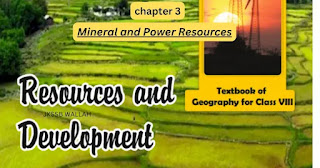Mineral and Power Resources
1. Answer the following questions.
(i) Name any three common minerals used by you every day.
Ans: Salt, petroleum, and gold are everyday minerals commonly utilized by humans.
(ii) What is an ore? Where are the ores of metallic minerals generally located?
Ans: Ores are rocks from which minerals are extracted. Minerals can be found in different rock types – igneous, metamorphic, and sedimentary. Metallic mineral ores are usually found in igneous and metamorphic rocks, forming large plateaus.
(iii) Name two regions rich in natural gas resources.
Ans: The UK and the Netherlands are big natural gas producers. It is found in petroleum deposits and released during oil extraction. Used as fuel for homes and industries.
(iv) Which sources of energy would you suggest for (a) rural areas, (b) coastal areas, and (c) Arid regions?
Ans: (a) Rural areas can use coal, solar energy, bio-gas, and firewood as energy sources.
(b) Coastal areas can utilize wind power, petroleum, and tidal power.
(c) Arid areas can benefit from geothermal power and solar energy as suitable energy sources.
(v) Give five ways in which you can save energy at home.
Ans: To save energy and be more eco-friendly, we can:
1. Turn off lights, TV, and electric fans when not in use.
2. Ensure taps are closed tightly to prevent dripping.
3. Use a pressure cooker for cooking to save energy.
4. Opt for walking or cycling for short-distance commutes.
5. Minimize the use of refrigerators, air conditioners, and lifts to reduce energy consumption.
2. Tick the correct answer.
(i) Which one of the following is NOT a characteristic of minerals?
(a) They are created by natural processes.
(b) They have a definite chemical composition.
(c) They are inexhaustible.
(d) Their distribution is uneven.
(ii) Which one of the following is a leading producer of copper in the world?
(a) Bolivia
(b) Ghana
(c) Zimbabwe
(d) Chile
(iii) Which one of the following practices will NOT conserve LPG in your kitchen?
(a) Cooking food in an open pan, kept on a low flame.
(b) Soaking the dal for some time before cooking it.
(c) Cooking food in a pressure cooker.
(d) Keeping the vegetables chopped before lighting the gas for cooking.
3. Give reasons.
(i) Environmental aspects must be carefully looked into before building huge dams.
Ans: Constructing a big dam causes harm to natural vegetation and wildlife in submerged areas. Hence, environmental factors should be considered before building such dams.
(ii) Most industries are concentrated around coal mines.
Ans: Coal is a vital energy source, leading to the concentration of industries around coal mines.
(iii) Petroleum is referred to as “black gold”.
Ans: Petroleum is a thick black liquid, often called “black gold” for its value in various industries.
(iv) Quarrying can become a major environmental concern
Ans: Quarrying creates problems such as airborne dust causing respiratory issues and destroying natural vegetation, impacting wildlife habitats.
4. Distinguish between the following.
(i) Conventional and non-conventional sources of energy
Ans:
| Conventional Energy Sources | Non-Conventional Energy Sources |
|---|---|
| Traditional and widely used sources. | Modern and sustainable alternatives. |
| Examples: Fossil fuels, nuclear energy, etc. | Examples: Solar energy, wind energy, etc. |
| Limited and finite resources. | Renewable and virtually infinite. |
| High greenhouse gas emissions and air pollution. | Low carbon footprint and eco-friendly. |
| Finite and depletable, facing future challenges. | Sustainable and future-oriented solution for energy needs. |
(ii) Biogas and natural gas
.Ans:
| Biogas | Natural Gas |
|---|---|
| Produced from organic waste and biomass. | Extracted from fossil fuel deposits. |
| Renewable and eco-friendly. | Non-renewable and fossil-based. |
| Composed of methane and carbon dioxide. | Composed primarily of methane. |
| Produced through anaerobic digestion. | Formed through geological processes. |
| Local production potential (on-site). | Requires complex extraction systems. |
(iii) Ferrous and non-ferrous minerals
Ans:
| Ferrous Minerals | Non-Ferrous Minerals |
|---|---|
| Contain iron as the main component. | Do not contain iron as the main component. |
| Examples: Iron ore, manganese, etc. | Examples: Copper, lead, zinc, aluminum, etc. |
| Widely used in the steel industry. | Used in various industries, excluding steel. |
| Magnetic properties due to iron. | Generally non-magnetic. |
| Prone to rusting and corrosion. | Generally resistant to rust and corrosion. |
(iv) Metallic and non-metallic minerals
Ans:
| Metallic Minerals | Non-Metallic Minerals |
|---|---|
| Contain metals in their composition. | Lack metals in their composition. |
| Examples: Iron ore, copper, gold, etc. | Examples: Quartz, limestone, gypsum, etc. |
| Often used in industries for their metal properties. | Utilized mainly in construction, ceramics, and glass-making. |
| Typically have high electrical conductivity and ductility. | Generally lack electrical conductivity and malleability. |
| Valuable for their metal content and economic importance. | Valuable for their industrial and commercial applications. |

